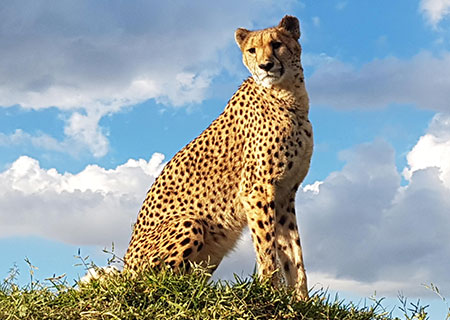
116, Part 5. The Civilized Massacre
The night before we were due to leave Swaziland, Neil and Bernie decided to visit the local Mbabane “Niteclub.” Hero had called me earlier to announce that she was pregnant again with our fourth child. At one level I was delighted but I was also freaked out over the growing costs of maintaining our expanding tribe. I was in no mood to go partying.
The following morning a rather bleary-eyed Neil appeared and joined me for breakfast. There was no sign of Bernie. This was before the era of cell phones, so we had to wait until Bernie made contact. At about 11 a.m. the phone rang in my room. An almost incoherent Bernie asked if we could come and fetch him. I asked where he was. There was a long silence and then I heard some voices apparently talking to our sound man, who was at that stage clearly unsound!
Finally, an African woman spoke on the phone and said that Bernie would wait for us at a garage in some remote village many miles from Mbabane. Gritting my teeth, I asked her to spell out the name of the village and told her to tell Bernie we would fetch him as soon as we could. I then went to the hotel reception and asked if they could tell me the way to the village. The receptionist gave me a funny look but pulled out a map of Swaziland and showed me where it was. Fortunately, it was not too far from the main road to the South African border. We arrived there about an hour later to find a very disheveled but cheerful Bernie waiting at the garage. He staggered into the car and asked if we had brought his luggage with us. We had. I didn’t even bother to reprimand him. No sooner had he hit the back seat, his head fell back, and he was out for the count. We learned later that he had gone in a taxi with a girl from the club and had passed out before arriving at the village where she lived. Later he did apologize to me and I left it at that.

We left Swaziland and headed for Duivelskloof in the Northern Province but stopped along the way to visit the Loskop Dam Cheetah Sanctuary. Brian Varaday, a film editor whom I knew from Killarney Film Studios, had told me about his father Desmond Varaday’s cheetah sanctuary. These beautiful creatures had for many years been considered vermin by local farmers because of their raids on farms where they would hunt and kill domestic animals. As the species became seriously endangered, people like Hungarian-born Desmond set up sanctuaries where cheetahs could be bred in safety. From the 1970s, laws were introduced to protect these very special animals. Desmond and others probably saved the cheetah from extinction. We spent a wonderful afternoon in the Cheetah Sanctuary. I was allowed to actually play with a couple of the tamer cheetahs but had to remain mindful of the fact that they are still at heart wild animals. If they feel at all threatened, they can become dangerous. It was heartening to find that there are so many small parks and sanctuaries scattered around the country, doing their best to preserve the indigenous flora and fauna of Africa.
We then set off for our final destination, a visit to Charles Astley Maberly’s farm, Narina. Looking through my earlier blogs I found that blog 49 contains a detailed description of our visit to the world-famous writer and illustrator of wildlife. There’s no point in repeating it all here so I will rather focus more on the person that had a huge influence on Charles’ life, the founder of the Kruger National Park, Major James Stevenson-Hamilton. Hopefully, you will go back to blog 49 to get the full story that I will only touch on here.
One of the major problems with establishing game parks and reserves for wildlife in the late 1800s was the complete lack of comprehension for the need to do so. The Cape Dutch (later Afrikaners) who formed the Great Trek in search of new farmlands and freedom from the oppressive British rule of the Cape, encountered massive herds of game wherever they went. They were mostly good hunters and fine horsemen. Game to them was as simple as plucking an orange from a tree.
Paul Kruger, President of the Transvaal Republic, had the foresight to realize that at the rate his people were hunting, the indigenous wildlife would eventually become scarce. He pleaded with his parliament to create game reserves and parks to protect the wildlife but to no avail. He succeeded in changing some game laws in 1891 but it was only in 1898 that he was able to proclaim a Goewerments Wildtuin (Government Wildlife Park) between the Crocodile and Sabi Rivers in the Eastern Transvaal called the Sabi Nature Reserve. Unfortunately, the two Anglo-Boer wars took place shortly thereafter and nothing much was done to establish a well-protected game reserve.
The wars were over by 1902 and Paul Kruger died in 1904. The victorious British appointed Lord Alfred Milner as Governor of the Transvaal. He, like Paul Kruger, realized the growing need to protect Africa’s flora and fauna. He approached the British army in search of a suitable person to run the reserve. Major James Stevenson-Hamilton was approached and seconded to the Reserve as its first Warden. He was instructed to make himself generally disagreeable in the process of imposing law and order within the Reserve.
Stevenson-Hamilton did just that, initially. He issued an order that no shooting was allowed in the region, saying that if he and his men could survive on tinned meat so could the local white farmers and the African community. He and his small team caught many poachers until it became clear that he meant business. He even had a group of senior policemen arrested and fined for killing game. He was effectively magistrate, customs collector and border guard. As soon as he had established control over the Nature Reserve, he went to Johannesburg and Pretoria to ask businessmen for more land. He was eventually given a huge tract of land in a remote corner of the Transvaal, effectively extending the Reserve from 1,200 to 14,000 square miles, making it the largest game park in the world.
Despite his strict management of the area, he was perceived as being a very fair administrator. He actually became a good friend of the Tsongo people, the local African tribe in the area, even learning to speak their language. He studied and absorbed Tsongo culture as well as studying their methods of hunting wildlife. The Tsongo people’s respect for him grew to the extent that when he died in 1957, some of the old Tsongo tribesmen who had been imprisoned by him for poaching said, “A great man has gone.” They gave him the nickname of Skukusa which means “The man who turns everything upside-down” or “the man who sweeps clean.” Clearly, they appreciated the way in which he sorted out the Reserve even though they had to change their own lifestyles to accommodate his wishes. Today, Skukusa Camp is one of the main centers of food and accommodation inside the park, which In 1927 was renamed the Kruger National Park in honor of the foresight of the late Paul Kruger in respect of conservation of the environment.
In 1923, an eighteen-year-old Englishman, Charles Astley Maberly, travelled to South Africa. He had already established a reputation as a gifted illustrator of flora and fauna, and he was determined to use his skills to capture the wildlife of Southern Africa. He stayed on a farm close to the Sabi Nature Reserve which was still four years away from being named the Kruger National Park. Stevenson-Hamilton had by now established his rules pertaining to anyone entering the Reserve. Both the white farmers and the local Tsongo community had grown to respect his aims in preserving the wildlife within the Reserve. Over the years there was a growing awareness of the importance of keeping both hunters and poachers out of the area. Stevenson-Hamilton was understandably horrified when he received reports of a young white man riding a bicycle through the Reserve. He sent his game rangers out to apprehend the lunatic. Charles was found and unceremoniously brought in front of the Warden. Charles explained that he was an illustrator and he was simply sketching the animals that he found. Stevenson-Hamilton shook his head in disbelief and promptly banned Charles from entering the park, saying that he had no wish to send his remains back to England – if indeed there was anything left after a lion had decided to have Charles for lunch.
It took a while, but Charles nagged the Warden, saying that his writing and illustrations would serve to promote the Reserve both locally and overseas. Stevenson-Hamilton was in the gradual process of getting permission to allow visitors into the Reserve. He could see the advantages of Charles producing written and illustrated works featuring the wildlife in the Reserve. He finally proposed a compromise. He would allow Charles into the Reserve provided he carried a gun with him. He added that the gun should only be used in an extreme emergency. Charles agreed and shortly afterwards returned to England where his wealthy aunt asked the young man what he would like for a present? Charles replied that he needed a gun, but it would have to be a short-barreled version that he could carry with him on his bike.
Neil, Bernie and I visited Charles mainly in the hope of filming the rare, nocturnal bush pigs that he had over many months persuaded to come out of the forest surrounding his farm, Narina, and feed on his lawn. These creatures had never been filmed before. Sadly, they did not oblige us and stayed in the forest while we were there. But we did get to see Charles’ magnificent sawn-off shotgun, custom built by the top gunsmiths in London with superb inlay on the stock. It was a gun enthusiast’s dream. Its makers would have been horrified to see Charles lash it firmly to the crossbar of his bicycle. I estimate it would have taken at least five to ten minutes to untie it and Charles’ only hope of effectively using it would be to point the bike in the direction of the lion or other attacking creature and fire from the crossbar, undoubtedly blowing up the handlebars in the process! Charles led a charmed life with his adventures in the Reserve, later called the Kruger National Park, and produced many of the finest illustrations of the twentieth century. His books sold well across the world and the park benefitted from his work.
We returned with some good footage from our travels and the pilot film was edited to show the potential of a full-length ninety-minute documentary. Dennis and I travelled to the Building Society confident that we would be financed to complete the film. The Chairman told us that the board had agreed in principle, but they were holding their annual general meeting of all shareholders later that week, and as a formality they would mention their desire to finance the film. They did not foresee a problem.
Sadly, one of the major shareholders had had a disastrous experience with a movie project. He spoke passionately against the idea and swayed other members to side with him. Net result, we were not financed! It was the only documentary I ever shot, or partially so, that was never completed.
Dennis and I fell out over the situation and despite the hope that we would find another finance source, our disagreement made things worse. Hero and I moved into different houses over the following few years and some of the footage was eventually damaged by water seepage. I eventually, reluctantly abandoned the “Civilized Massacre,” having frequently failed to find further financing to complete the film. In a small way writing about it here has eased the frustration of the project. Hopefully, some other younger filmmaker may pick up the idea and run with it.
The major lesson learned from the experience was to never give up on a project that has a real value. I have never done so again. On a brighter note, I feel really excited by the steady progress of ExoTech despite numerous barriers placed in its way. I have huge certainty that it is a project that will soon emerge as one of the most significant technical developments of the twenty-first century. It will not be stopped; and I am honored to have been some small part of it.

